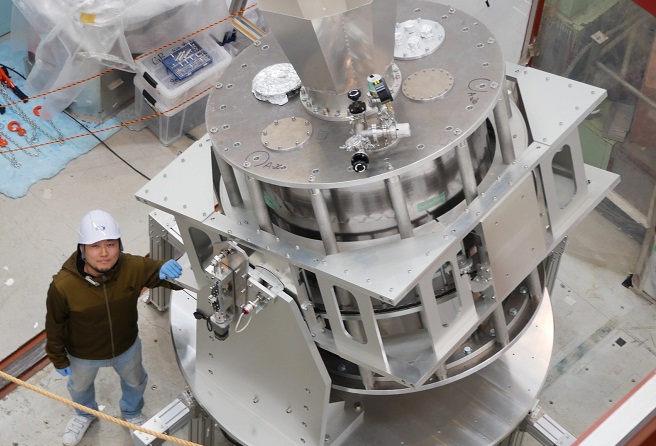Telescope for Observing Primordial Gravitational Waves Revealed
November 27, 2018
Tsukuba, Ibaraki Pref.--Japan's High Energy Accelerator Research Organization, or KEK, Kyoto University and other institutes have shown to the media a telescope called GroundBIRD with which they aims to observe primordial gravitational waves that are believed to have been emitted right after the birth of the universe.
The telescope was unveiled at KEK's facility in the city of Tsukuba, Ibaraki Prefecture, eastern Japan.
The interior of the telescope can be cooled to near absolute zero, or minus 273.15 degrees Celsius, for reducing interference.
Its sensor, measuring about 1.4 meters in diameter, rotates once in every three seconds, enabling the observation of areas 20 times broader than those covered by conventional telescopes of this kind and reducing impacts from atmospheric seeing, according to the institutes.
A widely accepted theory regarding the origin of the universe is the inflation theory, which claims the universe expanded rapidly right before the Big Bang.
Efforts to observe primordial gravitational waves are being made across the globe as their detection is expected to provide solid evidence for the inflation theory.
Using the GroundBIRD, the institutes aim to capture such waves by examining the intensity and features of the electromagnetic waves that strike Earth.
They will send the telescope to the Canary Islands, a Spanish archipelago in the Atlantic Ocean, next month at the earliest, hoping to start observations in April 2019. Jiji Press
Latest Videos
- THE UNTOLD STORY EXPERT INSIGHTS INTO THE UKRAINE
- NEGOTIATING A NEW ORDER US RUSSIA TALKS ON UKRAIN
- Ukraine: A Pawn in the Geopolitical Game? Will Trump Intervene?
- US VP VANCE CRITICIZES EUROPEAN DEMOCRACIES AT MUNICH SECURITY CONFERENCE
- UNCOVERING THE WEB OF DECEIT: CIA INFILTRATION OF THE MEDIA
- SHIFTING SANDS: TULSI GABBARD’S CONFIRMATION AND THE EVOLVING GLOBAL LANDSCAPE
- FAUCI SCANDAL: A THREAT TO GLOBAL HEALTH AND DEMOCRACY






